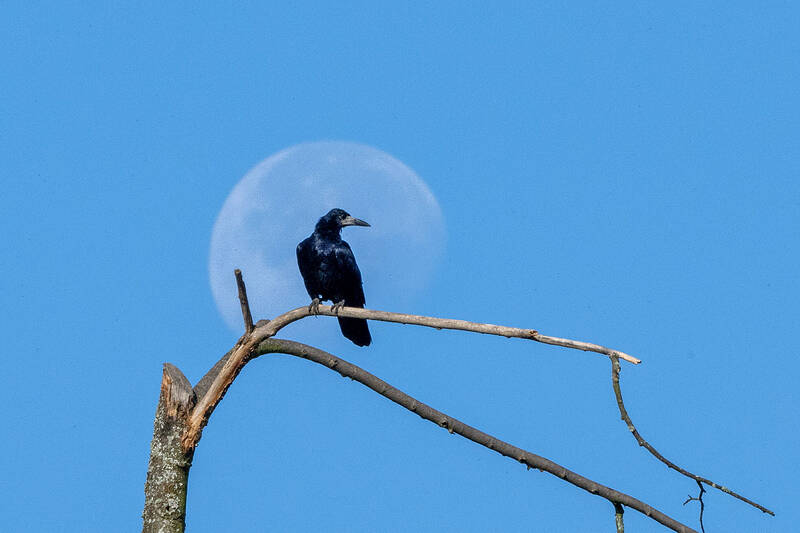Day and night will get equal time for a brief moment on Tuesday as much of the world heads into fall.
The autumnal equinox arrives Tuesday, marking the start of the fall season for the Northern Hemisphere and the spring in the Southern Hemisphere. On the equator, the sun will be directly overhead at noon. Equinoxes are the only times when both the north and south poles are lit by sunshine at the same time.
In the Northern Hemisphere, sunlight will gradually diminish each day until the winter solstice on Dec. 21.

Photo: EPA-EFE 照片:歐新社
Equinoxes have been marked and celebrated worldwide for centuries. The fall equinox is often connected with harvest festivals in the Northern Hemisphere. For example, Dozynki, the harvest festival celebrated in Poland and other Eastern European countries, was thought to have been originally tied to the equinox. At the Mayan site Chichen Itza in Mexico, people gather during the equinox to watch the sun create a shadow pattern that resembles a serpent descending a building called El Castillo.
This year, there’s a bonus for some: Antarctica, New Zealand and a sliver of Australia may be able to see a partial lunar eclipse during their Monday.
WHAT IS THE EQUINOX?

Photo: EPA-EFE 照片:歐新社
As the Earth travels around the sun, it does so at an angle.
For most of the year, the Earth’s axis is tilted either toward or away from the sun. That means the sun’s warmth and light fall unequally on the northern and southern halves of the planet.
During the equinox, the Earth’s axis and its orbit align so that both hemispheres get an equal amount of sunlight.

Photo: EPA-EFE 照片:歐新社
The word equinox comes from two Latin words, meaning equal and night. That’s because on the equinox, day and night last almost the same amount of time — though one may get a few extra minutes, depending on where you are on the planet.
The Northern Hemisphere’s fall — or autumnal — equinox can land between Sept. 21 and 24, depending on the year. Its spring — or vernal — equinox can land between March 19 and 21.
WHAT IS THE SOLSTICE?

Photo: Chang Hsieh-sheng, Liberty Times 照片:自由時報記者張協
The solstices mark the times during the year when the Earth is at its most extreme tilt toward or away from the sun. This means the hemispheres are getting very different amounts of sunlight — and days and nights are at their most unequal.
During the Northern Hemisphere’s summer solstice, the upper half of the Earth is tilted in toward the sun, creating the longest day and shortest night of the year. This solstice falls between June 20 and 22.
Meanwhile, at the winter solstice, the Northern Hemisphere is leaning away from the sun — leading to the shortest day and longest night of the year. The winter solstice falls between Dec. 20 and 23.
WHAT’S THE DIFFERENCE BETWEEN METEOROLOGICAL AND ASTRONOMICAL SEASONS?
These are just two different ways to carve up the year.
While astronomical seasons depend on how the Earth moves around the sun, meteorological seasons are defined by the weather.
Meteorologists break down the year into three-month seasons based on annual temperature cycles. By that calendar, spring starts on March 1, summer on June 1, fall on Sept. 1 and winter on Dec. 1.
(AP)
白晝與黑夜的長度將會在本週二短暫相等,全球多數地區隨之邁入秋季。
秋分的到來,代表北半球秋季開始,以及南半球春季的開端。在赤道地區,正午時分太陽將直射頭頂。秋分與春分是全年唯一南北兩極同時有日照的時候。
在北半球,自秋分起,日照時間將逐日縮短,直至12月21日的冬至。
數百年來,全球各地都有慶祝分點的習俗,形式各異。秋分往往與北半球的豐收節慶相關。例如,波蘭及其他東歐國家的收穫節(Dozynki),據信最初便與秋分有關。在墨西哥的奇琴伊察(Chichen Itza)瑪雅遺址,人們於分點時聚集在一起,觀賞太陽在卡斯提略金字塔(El Castillo)上投下宛如巨蛇下行的光影。
今年,部分地區還有另一個天象驚喜:南極洲、紐西蘭及澳洲部分地區,當地的週一可見到月偏食。
什麼是「分點」?
地球繞行太陽時,地軸保持著一個傾斜角度。
在一年的大部分時間,地軸不是傾向太陽,就是背離太陽,導致陽光與熱在南北半球分布不均。
而在分點時,地軸與公轉軌道對齊,使得南北兩半球得到幾乎相等的日照。
「Equinox」一詞源自拉丁語,意為「相等的夜晚」。這是因為在分點期間,晝夜長度幾乎相同——雖然實際上可能因地理位置不同而有數分鐘的差別。
北半球的秋分通常是在9月21日至24日之間;春分則落在3月19日至21日之間。
什麼是「至點」?
至點是指地球地軸對太陽傾斜角度最大的兩個時刻,此時南北半球的日照差異最大,晝夜長短最不均衡。
在北半球的夏至,地軸向太陽傾斜,有全年最長的白晝與最短的黑夜。夏至通常落在6月20日至22日之間。
而在冬至,北半球背離太陽傾斜,形成全年最短的白晝與最長的黑夜。冬至落在12月20日至23日之間。
氣象季節與天文季節有何不同?
這是劃分年的兩種方式。
天文季節依據地球繞太陽運行的位置劃分;氣象季節則依據天氣與氣候模式來界定。
氣象學家將一年分為四個季節,每季有三個月,以年均溫為循環周期:春季自3月1日開始,夏季自6月1日開始,秋季自9月1日開始,冬季自12月1日開始。
(台北時報林俐凱編譯)

Have you ever seen a circular intersection where cars continuously flow in one direction around a central island? That is a “roundabout,” a well-known alternative to traditional intersections. Drivers enter and exit at different points without relying on traffic lights. Their primary purpose is to improve traffic flow and minimize the likelihood of high-speed collisions, particularly dangerous T-bone and head-on crashes. Roundabouts have existed and been implemented for over a century. In the 1960s, the modern roundabout emerged in the UK, with added rules for yielding. Unlike intersections with red lights, roundabouts allow vehicles to continue moving at a

A: So you’re reading Jin Yong’s martial arts novel again? B: Yup, Jin’s novels are so fascinating, especially the trilogy: “Legends of the Condor Heroes,” “Return of the Condor Heroes,” and “Heaven Sword and Dragon Saber.” A: The late novelist published his first story in 1955, which means this year marks the 70th anniversary of his “wuxia” world. B: Wasn’t an English version of “Legends of the Condor Heroes” also released in 2018? A: Yes, but the debate over the translation of kung fu moves continues — like the evil move “Nine Yin Skeleton Claw.” A: 你又在重讀金庸的武俠小說啦? B:

If you’ve recently spotted adults parading around with cuddly toys dangling from their designer handbags, your eyes haven’t been deceiving you. The playful trend of adorning bags with cute charms has become popular among people of various ages. Plushies like Labubu and anime and manga characters such as Chiikawa have become must-have accessories that make personal statements. The practice of attaching charms to personal items has been common across cultures throughout history. In ancient civilizations, charms were often used as symbols of protection, good luck, or identity. Fast-forward to more modern times, and style icons like Jane Birkin, a

A: Apart from Jin Yong, the late martial arts novelists Liang Yusheng and Gu Long were also very popular. B: Wasn’t Liang a pioneer of the “new school” wuxia genre in the 20th century? A: Yup, I really like his Tianshan mountain series. All the characters — such as the “White Haired Demoness” — are so vivid. B: The roles in Gu’s books are lively, too — like the “Fragrant Commander” Chu Liuxiang. A: And the TV drama adapted from the Chu Liuxiang series swept across Taiwan in the 1980s, with ratings surging over 70 percent at that time.